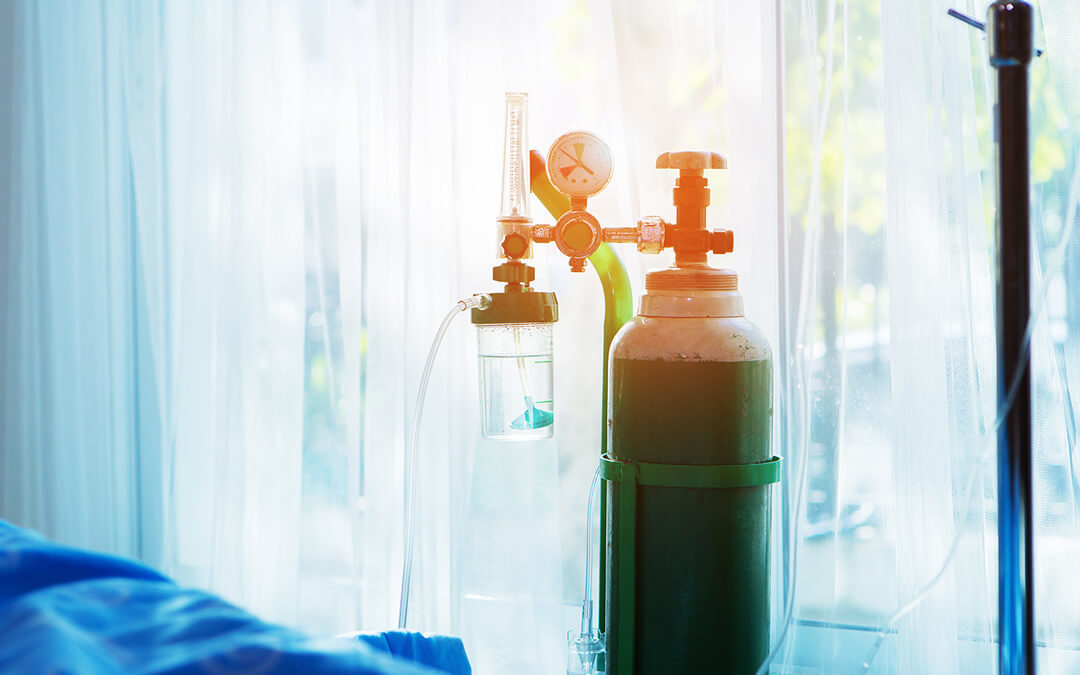As the COVID-19 pandemic has been sweeping the nation, the importance of medical oxygen service has come to the forefront of our communities and everyday conversations. The medical condition known as “silent hypoxia” hit the headlines when COVID-19 began presenting itself in hospital emergency rooms across the country. According to LiveScience, concern for the patients with “silent hypoxia” is that patients’ health may be worse than they present or realize:
“Their lungs are clearly not effectively oxygenating the blood, but these patients are alert and feeling relatively well, even as doctors debate whether to intubate them by placing a breathing tube down the throat.”
E.R. doctor Richard Levitan, in a recent New York Times Op-Ed that gained significant attention, noted the importance of oxygen monitoring devices, or pulse oximeters, for saving people’s lives. These devices allow sick patients to monitor their oxygen levels at home and seek medical treatment sooner rather than later.
So, how did the field of medicine—and its relationship with oxygen—advance to the point of being able to use at-home devices such as the pulse oximeter to avoid medically invasive procedures? We’ll journey into a brief history of oxygen in order to understand where we stand today.
What is in a Name?
What the medical community calls “oxygen” is not actually oxygen, but dioxygen or “O2″—the “stable molecular form of elemental oxygen (“O”). As you already know, oxygen is essential to life on the planet and to optimal life and health in the human body.
Oxygen is First Discovered
Oxygen was first discovered in 1771 when a German-Swedish pharmaceutical chemist by the name of Carl Wilhelm Scheele heated mercuric oxide, silver carbonate, magnesium nitrate, and other nitrate salts—creating what he called “fire air.” Just six years later, Scheele published Chemical Treatise on Air and Fire, detailing his discoveries, including oxygen. Unfortunately, what Scheele discovered—the workings of chemical elements such as the heating of mercuric oxides to generate oxygen—also resulted in his premature death from mercury poisoning.
Oxygen is First Used to Treat Asthma and Congestive Heart Failure
In 1789, a man by the name of Thomas Beddoes who was considered the “father of respiratory therapy” opened the Pneumatic Institute in Bristol, England. The Institute treated medical conditions such as congestive heart failure and asthma through the application of oxygen and nitrous oxide.
While Beddoes continued to work with another inventor, James Watt, to generate oxygen and other gases, the typhus epidemic forced the Institute to close, but apothecaries continued to offer oxygen during the 18th and 19th centuries.
Oxygen is Used for General Anesthesia
One hundred years later, in 1885, oxygen was used to pioneer new techniques in the medical field. Prior to the late 19th century, there had been no way to effectively store oxygen. However, with the invention of the oxygen cylinder—or the oxygen therapy apparatus—in 1868, oxygen was now able to be put to use in general anesthesia or for surgical procedures.
Oxygen Therapy Comes to the United States
Leapfrog into the mid-twentieth century, when new medical advances were made with oxygen. In the 1950s, for example, Dr. Alvan Barach—who first introduced oxygen therapy to the United States—”used trans filled oxygen bottles for ambulatory patients with exertional dyspnea” (or shortness of breath during exertion or exercise). This was a significant advancement in the field. During that same time period, three other medical practitioners: Coats, Gilson, and Pierce, were able to use oxygen in small, portable cylinders to treat patients with lung disease, noting significant improvements in their symptoms.
Oxygen Level Becomes the Fifth Vital Sign
In the 1970s in Japan, an engineer by the name of Takuo Aoyagi invented the pulse oximeter, which, according to Courtney Broaddus, professor emeritus of medicine at the University of California, San Francisco is “an indispensable addition to medicine.” In a New York Times interview, Broaddus noted that oxygen has become “the fifth vital sign” (joining the other four: respiratory rate, pulse, blood pressure, and temperature) of a person’s life and health.
Conclusion
With all the talk these days about oxygen and oxygen therapy, we can be thankful for the women and men who pioneered in this area of medicine, making the advances that are now saving lives today.
To learn more about CalOx’s services and offerings, contact us today.
i John E Heffner. “The Story of Oxygen.” Respiratory Care Jan 2013, 58 (1) 18-31; DOI: 10.4187/respcare.01831
https://rc.rcjournal.com/content/58/1/18
ii 1911 Encyclopedia Britannica. Scheele, Karl Wilhelm. Wikipedia. https://en.wikisource.org/wiki/1911_Encyclopædia_Britannica/Scheele_Karl_Wilhelm.
iii John E Heffner. “The Story of Oxygen.” Respiratory Care Jan 2013, 58 (1) 18-31; DOI: 10.4187/respcare.01831
https://rc.rcjournal.com/content/58/1/18
iv Hess DR, MacIntyre NR, Mishoe SC, Galvin WF, Ward JJ. History of the respiratory care profession. In: Hess DR, MacIntyre NR, Mishoe SC, Galvin WF, editors. Respiratory care: principles and practice, 2nd edition. Jones & Bartlett; 2011:1392-1400.
v Ibid
vi Leigh JM. The evolution of oxygen therapy apparatus. Anesthesia 1974;29(4):462-485.
vii Barach AL, Bickerman HA, Beck. Advances in the treatment of non-tuberculous pulmonary disease. Bull N Y Acad Med 1952;28(6):353-384.
viii Pierce AK, Paez PN, Miller WF. Exercise training with the aid of a portable oxygen supply in patients with emphysema. Am Rev Respir Dis 1965; 91:653-659.
